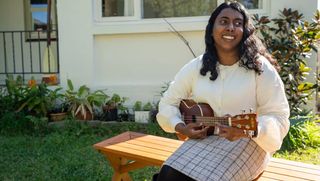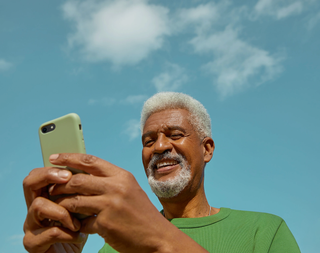Living with retinitis pigmentosa - Abby's story
Abby shares her journey with retinitis pigmentosa and the mindset that has helped her adapt and thrive as her vision changed over time in an interview with SeeWay writer Holly Kelly.


Summary
I first met Abby through her role as an Assistive Technology Specialist at Guide Dogs NSW/ACT. With her calm energy, warm smile, and natural ability to make people feel at ease, she’s the kind of person others naturally gravitate toward.
What I didn’t know at the time was that behind that welcoming presence was also a classically trained musician, a researcher, an accessibility advocate - and someone with a lived experience of vision loss that has shaped a remarkably thoughtful and creative approach to life.
In this story, Abby shares her journey with retinitis pigmentosa - from early diagnosis to university research and accessible design - and the mindset that has helped her adapt and thrive as her vision changed over time.
For Abby, growing up with retinitis pigmentosa wasn’t a story of dramatic turning points or sudden setbacks - it was a slow, steady adaptation to change. Diagnosed at the age of three thanks to the sharp instincts of an aunt who noticed her gravitating to light and contrast, Abby has lived most of her life with the understanding that her vision would continue to change.
“I always knew,” she says. “Even when I was little, I knew it would progress over time. But it wasn’t something I always struggled with - it was just part of who I was.”
Abby’s calm, practical outlook has shaped a life full of creativity, learning, and advocacy – grounded in a deep resourcefulness that has taken her from university lecture halls to music studios and conference stages.
Abby credits one of the most formative parts of her early schooling to something simple but powerful: learning to touch type.
“It’s the thing I always recommend,” she says. “If you’re starting your vision journey, touch typing is what keeps the digital gateway open.”
She began using a laptop in primary school, learning to navigate the keyboard by touch rather than sight - a skill that would become essential as her vision changed and digital life became increasingly central.
Abby’s love of music led her to university, where she completed a Bachelor of Music and later undertook a significant research project that explored the work of a Sri Lankan musician through the lens of politics, language, and cultural identity.
“It was like working full time,” she says of her research. “I was looking at how music responded to societal shifts - language, Buddhist revival, anti-colonial sentiment. It was really deep work.”
While completing her degree, Abby also worked on a university project to make course materials accessible for students who were blind or had low vision. It required her to learn how to use a screen reader for the first time, adapting quickly so she could test materials for usability. The experience was eye-opening.
“I turned on the screen reader and it just said things like ‘box’ and ‘rectangle.’ There was no context. That’s when I realised - something might look good visually, but it still has to be accessible.”
The work led to a keynote presentation at a learning summit and sparked meaningful conversations about inclusive design.
When vision changes, so does the approach
By the time she finished her research, Abby’s vision had shifted significantly. Reading physical text became tiring and inefficient, so she leaned into technology more fully.
“I moved everything to digital. I’d scan books, use OCR (text recognition), and then highlight passages on my laptop. The screen reader helped me navigate faster - and in some ways, it actually made my research more efficient.”
Abby’s approach to screen readers and other tools is a mix of practicality and curiosity. She adapts quickly, learns what works, and lets go of what doesn’t.
“I’d try something a few times, and if it didn’t work, I’d just find another way,” she says.
That mindset - flexible, positive, and grounded - runs through every part of her story.
Misconceptions about low vision
Abby is quick to point out that not all vision loss is visible - and not all people who use a cane or assistive tech are completely blind.
“People often assume if you look like you’re functioning without difficulty then you must be able to see,” she says. “But low vision is a spectrum. Someone might use a guide dog and still be able to read their phone. Or they might not use a cane but still need help reading a menu.”
She also highlights how common misunderstandings can create awkwardness.
“It’s frustrating when people hold up fingers and ask, ‘how many can you see?’ It’s not helpful - and it really doesn’t tell you much about what someone can or can’t do.”
Her message is clear: Don’t make assumptions. Vision loss looks different for everyone.
Abby continues to find new ways to do what she loves. She’s learning Braille, creating music, and even using AI tools to help translate song lyrics from other languages or format musical scores for screen reader compatibility.
Advice for others on a low vision journey
Abby doesn’t sugarcoat the challenges of progressive vision loss - but she believes in what’s possible.
"There is life after vision loss,” she says. “You can adapt your hobbies, you can find different ways of doing things… managing cooking, getting support, accessing technologies - there are still ways to do that, even for people with no vision.”
Her story is about building a life that works - one that’s rich with learning, creativity, and advocacy.
Thank you to Abby for generously sharing her story and insights. Visit Abby's YouTube channel to check out her musical talents.
Enjoying the content?
Start building your profile to access personalised support, resources, and tools tailored to your eye health journey.
